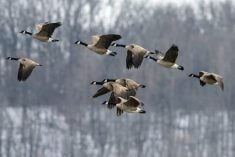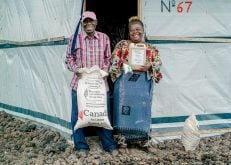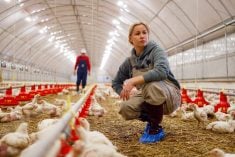BROMONT, Que. — Building the profile of forages and grasslands in Canada has been easy compared to raising money to fund the sector’s national organization.
The Canadian Forage and Grasslands Association will have about $3,000 in the bank by the end of the year.
Higher than expected costs to promote forages and the ending of funding agreements have placed the organization in a difficult position.
“The board is very determined to carry on, retrench and establish the financial viability of this organization,” said association chair Doug Wray during the annual conference.
Read Also

How we’re tracking avian flu’s toll on wildlife across North America
Avian influenza is a virus that is clearly a threat to livestock and human health. Our team, a collaboration of governments and academics across the country, recently assessed the extent of HPAI A(H5Nx) in at-risk species across Canada.
“We heard so many interesting and good research over the last two days. It just reconfirms there is real value in what we’re doing. We have been very successful in raising the profile of forages. We built up a head of steam and don’t have the dollars flowing to keep it going. Nobody is saying we’re going to shut it down. Just because things aren’t easy doesn’t mean you stop.”
Executive director Ron Pidskalny resigned during the convention.
Pidskalny said he was hired to develop strategic partnerships and make the group more sustainable over the long term. Instead, he was bogged down by daily tasks.
The association was formed five years ago to raise the profile of forages in Canada and provide a national voice for forages and forage issues.
Pidskalny and board members flew to Ottawa to talk to the House of Commons’ agriculture committee, joined forces with the Commission for Environmental Co-operation to promote good land management, developed timothy hay export strategies for China and worked hard to sell the benefits of forages.
Promoting and developing an industry takes money, but the association has no annual check-off revenue or guaranteed funds. Much of the work applying for grants, organizing conferences and translating texts from English to French was left to Pidskalny or the volunteers from the provincial associations.
“It is really difficult to develop a long-term strategy when the finances are piecemeal,” he said.
Pidskalny said he believed the organization was on more secure funding when he was hired last year.
The Canadian Cattlemen’s Association had pledged $20,000 for three years, but it was not renewed at the end of the year.
Dairy Farmers of Canada pledged $10,000 a year, but it must be asked for each year and is not guaranteed.
“I thought the $30,000 was ongoing funding as an annual contribution,” said Pidskalny.
“When we sent an invoice to the CCA for $20,000 we were asked to reapply. We put together a presentation to the environment committee and they actually cut us off completely, I am not sure where the relationship is going with the beef sector.”
The Dairy Farmers of Canada board has said its support will be assessed year by year.
Forages represent the largest cultivated crop in Canada with an estimated value of $5.1 billion. Almost every farm and ranch has grassland, hay or forage that they use to feed livestock or grow for hay or seed, but the forage association has no way to tap into the crop for cash.
The association had $23,000 in its bank account as of Oct. 31, but $20,000 worth of bills need to be paid by the end of the year.
The new fiscal year begins March 1, when the association can start sending out membership renewal notices.
Wray said higher corn, canola and soybean yields are making it increasingly difficult to convince producers to leave land in forages.
“We’re going to have to fight for those acres and learn how to manage them so the beef cow becomes competitive on those acres again.”
Part of the organization’s work is to highlight ways farmers and researchers across Canada are able to maximize yields from their grass and hayland.
Wray said the association hopes to hold its convention again next year.
“These things, while they’re costly, are also very empowering,” he said.
“There is a benefit to them. It will be contingent on us marshalling the resources to do it.”
Wray said the association hopes to hire a new executive director once its finances are more stable.














